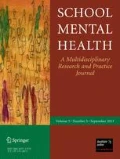Abstract
A recent study evaluated the level of guidance provided by states on their Department of Education web sites regarding school-based social, emotional, and behavioral (SEB) screening. The purpose of this follow-up study was to interview a small sample of state-level stakeholders to supplement the findings from the web site evaluation study. Specifically, current goals were to (a) confirm findings from the web search and coding of state department of education materials and (b) add perspectives on the history, current, and future landscape of SEB policies and initiatives in K-12 education in that state. Results of the current study demonstrated that participants agreed with the initial study findings regarding the guidance provided by state departments of education to K-12 schools around SEB screening. Further, most participants indicated additional future directions regarding the landscape of SEB screening in their state since the period in which the primary document information was captured. Results of this exploratory study indicate that although the current and future of SEB screening varies across states, key stakeholders within state Departments of Education were aware of the importance, need, and relevance of SEB screening in K-12 schools.
Similar content being viewed by others
References
Association for Supervision and Curriculum Development (ASCD) & Centers for Disease Control and Prevention (CDC). (2014). Whole school, whole community, whole child: a collaborative approach to learning and health. Alexandria, VA: ASCD. Retrieved June 6, 2018, from http://www.ascd.org/ASCD/pdf/siteASCD/publications/wholechild/wscc-a-collaborative-approach.pdf.
Atkins, M. S., Hoagwood, K. E., Kutash, K., & Seidman, E. (2010). Toward the integration of education and mental health in schools. Administration and Policy in Mental Health and Mental Health Services Research, 37, 40–47. https://doi.org/10.1007/s10488-010-0299-7.
Bloom, B., & Dey, A. N. (2006). Summary health statistics for U.S. children: National Health Interview Survey, 2004. Vital and Health Statistics, 10, 1–85. https://www.ncbi.nlm.nih.gov/pubmed/16532761?report=abstract.
Braun, V., & Clarke, V. (2006). Using thematic analysis in psychology. Qualitative Research in Psychology, 3, 77–101.
Briesch, A. M., Chafouleas, S. M., & Chaffee, R. K. (2017). State-level priorities in school-based behavior screening policies and initiatives. School Mental Health. https://doi.org/10.1007/s12310-017-9232-5.
Bruhn, A. L., Woods-Groves, S., & Huddle, S. (2014). A preliminary investigation of emotional and behavioral screening practices in K-12 schools. Education and Treatment of Children, 37, 611–634.
Burns, B. J., Costello, E. J., Angold, A., Tweed, D., Stangl, D., Farmer, E. M., et al. (1995). Children’s mental health service use across service sectors. Health Affairs, 14, 147–159. https://doi.org/10.1377/hlthaff.14.3.147.
Catalano, R. F., Berglund, M. L., Ryan, J. A. M., Lonczak, H. S., & Hawkins, D. (2004). Positive youth development in the United States: Research findings on evaluations of positive youth development programs. The ANNALS of the American Academy of Political and Social Science, 591, 98–124.
Elo, S., & Kyngas, H. (2008). The qualitative content analysis process. Journal of Advanced Nursing, 62, 107–115. https://doi.org/10.1111/j.1365-2648.2007.04569.
Levitt, J. M., Saka, N., Romanelli, L. H., & Hoagwood, K. (2007). Early identification of mental health problems in schools: The status of instrumentation. Journal of School Psychology, 45, 163–191. https://doi.org/10.1016/j.jsp.2006.11.005.
Merikangas, K. R., He, J. P., Burstein, M., Swanson, S. A., Avenevoli, S., Cui, L., et al. (2010). Lifetime prevalence of mental disorders in US adolescents: results from the National Comorbidity Survey Replication-Adolescent Supplement (NCS-A). Journal of the American Academy of Child and Adolescent Psychiatry, 49, 980–989.
National Research Council. (2009). Preventing mental, emotional, and behavioral disorders among young people: Progress and possibilities. Washington, DC: The National Academies Press.
New Freedom Commission on Mental Health. (2003). Achieving the promise: Transforming mental health care in America. Final report DHHS Pub., Vol. SMA-03-3832, Author, Rockvillle, MD.
Owens, P. L., Hoagwood, K., Horwitz, S. H., Leaf, P. J., Poduska, J. M., Kellam, S. G., et al. (2002). Barriers to children’s mental health services. Journal of the American Academy of Child and Adolescent Psychiatry, 41, 731–738.
Rones, M., & Hoagwood, K. (2000). School-based mental health services: A research review. Clinical Child and Family Psychology Review, 3, 223–241.
U.S. Department of Health and Human Services. (1999). Mental health: A report of the Surgeon General. Rockville, MD: U.S. Department of Health and Human Services, SAMSHA, CMHS, NIH, NIMH.
Funding
This research was supported by funding provided by the Institute of Education Sciences, U.S. Department of Education (R305A140543 PI: Chafouleas).
Author information
Authors and Affiliations
Corresponding author
Ethics declarations
Conflict of interest
The authors declare that they have no conflicts of interest.
Ethical Approval
All procedures performed in this study involving human participants were in accordance with the ethical standards of the University of Connecticut Institutional Review Board.
Informed Consent
Informed consent was obtained from all individual participants included in the study.
Rights and permissions
About this article
Cite this article
Auerbach, E.R., Chafouleas, S.M. & Briesch, A.M. State-Level Guidance on School-Based Screening for Social, Emotional, and Behavioral Risk: A Follow-Up Study. School Mental Health 11, 141–147 (2019). https://doi.org/10.1007/s12310-018-9278-z
Published:
Issue Date:
DOI: https://doi.org/10.1007/s12310-018-9278-z




